The most commonly practiced technique in Karate, TKD, TSD and many styles of Kung Fu is Hikite, which is Japanese for pulling the hand back (usually to the hip), and is usually performed in conjunction with a punch, strike or “block”.
Applications for Hikite are usually depicted as grabbing the opponents wrist and pulling them on, whilst the other hand/arm attacks the opponent, either by striking or applying some kind of joint lock/break. You can see this application in some of the video’s below.
However, for this posting I would like to look at other self defence applications for Hikite when the fight get close in and dirty. I would like to approach this from the point of view of being attacked by an untrained thug, rather than a trained fighter (of any discipline). A trained fighter might well be able to cope with some of these tactics, but an untrained thug probably would not. And lets face it, we are more likely to be attacked by a thug, then by a disciplined and trained fighter.
Whenever a fist is made (in basics or kata/forms/patterns), it is quite safe to assume that it is either to strike or to grab. As Hikite is pulling back to the hip, then it is safe to assume that the fist in Hikite is grabbing.
First of all though let’s look at Hikite more closely as it varies from style to style. It normally starts with the arm extended, palm facing down. Some styles start with an open hand whilst others start with a fist. If the hand is open, then the first thing it does is to closes into a fist, which more or less gives all variations the same start point; a grab. From here, some styles rotate the fist to palm facing up as it starts to pull back to the hip. Other styles however, begin to pull back and rotate the fist to the palm up position near the end of the travel (as fist reaches the hip).
The applications covered in this article will work with either variation. However, in these specific applications, the twist is used to increase the pain threshold. I would therefore suggest that these specific applications will probably work better if the twist is performed at the beginning of the pullback, rather than at the end of the pullback.
The first application I would like to look at is pulling somebody’s hair. Although often considered “girly fighting”, it can be a good way to control an opponent (pain compliance) and brake their structure/balance. With a training partner try grabbing their hair and just holding, it will not be too uncomfortable for them. If you then pull, it hurts them. If you stop pulling, it stops hurting. This is why in a “girly fight”, they grab the hair and keep pulling backwards, forwards and sideways, to keep the pain going.
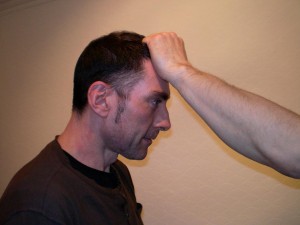
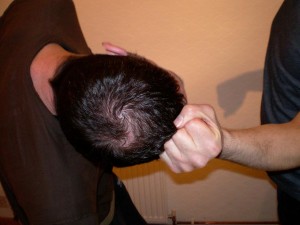
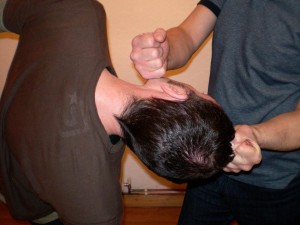
Now grab your partner’s hair and apply the Hikite. First just grab and twist. The act of twisting, drives the small knuckles of your fist into your training partners head and at the same time, maintains the pulling tension to the hair without you having to pull and push their head all over the place. Whereas with normal hair pulling, your training partner/opponent can move with the pull/push to lessen the effect, they cannot do anything to lessen the effect of your grab and twist. The pain is constant for as long as you keep the twist on.
Now pull back to the hip as usual and their structure and balance will be compromised as they are distracted with pain. It will also work if you pull first before twisting, but without the pain of the twist at the beginning, the opponent will be able to resist the pull a little bit more at this stage.
Once you have them prone, in pain with their head by your hip, if you judge the situation as being not too bad, then you may try to talk some sense into your prone opponent. If the situation is serious, then you can beat some sense into your opponent without them being able to resist very much.
This would have been particularly useful when these techniques were first introduced as many men wore their hair in a top-knot, which is quite easy to grab. However, today many men wear their hair short and many are, well . . . follicly challenged. In this scenario, grab the ear instead. There is a reason why many of us can remember parents and/or teachers grabbing us by the ears as kids; it because the ears are sensitive and it hurts. It just requires a bit more accuracy then grabbing hair.
Another application is grabbing the throat. This has to be reserved for all but the most serious of confrontations. Grabbing the throat and squeezing is always dangerous, but grabbing around the windpipe and twisting applies more pressure and can seriously damage the windpipe which can lead to death (and a long jail sentence). A much safer way, but still very effective, is to use a flesh (or skin) grab. This is common in many styles of Kung Fu, but has not been transmitted very much into Karate. For this application, let’s go back to when we first started to learn martial arts and 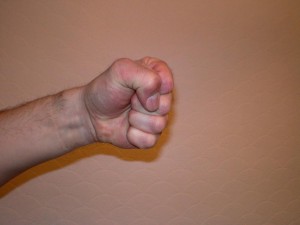
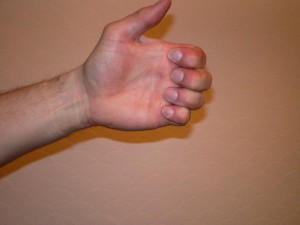 we
we 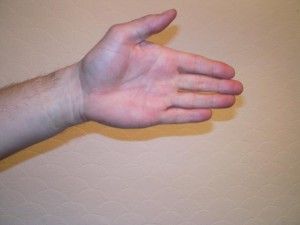 are taught how to make a correct fist. First, close up the outer set of knuckles (in the fingers), then close the last set of knuckles (where the fingers join the hand).
are taught how to make a correct fist. First, close up the outer set of knuckles (in the fingers), then close the last set of knuckles (where the fingers join the hand).
Try with a partner, clasping their neck, fingers one side and thumb the other side. Now close the first set of knuckles (in the fingers), but as you do so make sure that you secure some skin of the neck. Be careful with your training partner as this can be very painful and usually leaves marks. 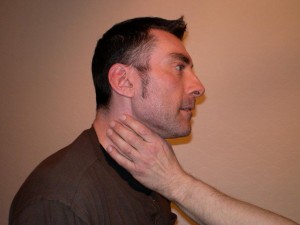
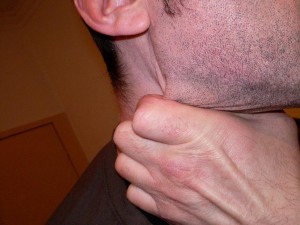
 Now continue to close up the rest of the fist, twist and pull (carefully). This is more painful than the hair pull, but you end up in almost the same prone position where you can talk or beat sense into your opponent.
Now continue to close up the rest of the fist, twist and pull (carefully). This is more painful than the hair pull, but you end up in almost the same prone position where you can talk or beat sense into your opponent.
If you are in a clinch and you are both trying to control each other, grabbing hair, ears or throats will be awkward, as obviously both of you will be trying to guard your heads from attack. However, whilst so close to each other, your opponent may not notice if you lower one hand to the side of their body, preferably just below their ribs, then grab lower torso flesh by closing up your first set of knuckles as before. You don’t need to grab large amounts of flesh, just some skin on the side will do. Then of course, grab, twist and pull. This should be enough to make them loosen their grip, off-balance them and give you the opportunity to land a clean blow.
Just be aware however that if the opponent is drunk or high on drugs, they may not feel the full effect. That said, as long as you can pull them off-balance, you can follow through.
Take another scenario where some thug has taken you to the floor and is sitting astride you trying to hit you. Grabbing the flesh around their waist, twisting and pulling will to say the least get their attention and probably stop them trying to hit you as they try to release your hands. From here, pull with one hand whilst pushing with the other to remove them sideways. This should be enough to move the average Joe thug; though again, be aware that if they are very drunk or high, they may not feel it so much.
Another defence if you are caught in this position is believe it or not gedan barai (lower sweeping block). The hand that you would normally “block” with is always pulled back to the opposite ear before sweeping downwards. Use this position to cover your head from your opponents blows. Your Hikite hand, slides down the centreline of your body until you find your opponents testicles. From here, your hand should already be in the palm up position (usually only here after twisting). Grab and pull at the same time as you sweep downward to push your by now very distraught opponent off you. You could actually twist your wrist in the opposite direction, just to add some insult to injury. If you opponent is too drunk to feel this, then he should be too drunk to walk, never mind fight.
Basics and kata/patterns don’t just teach techniques, they teach principles and the principle here is grab, twist and pull (or pull and twist depending on style). The flesh grabbing can be applied to most parts of the body, not just the examples above. Anywhere that you can grab flesh/skin, be it torso, limbs, head, wherever, this Hikite principle can be applied.
It should also be noted that our biceps are our main pulling muscles and our triceps are our main pushing muscles. To get the best pull, we want out biceps to be able to effectively contract. They contract better when we twist our palms upwards as Hikite teaches us to do. Hikite therefore teaches us to use our body in its strongest alignments.
This actually leads to one more application, such as pulling clothes. Although it does not directly cause pain, it can give a momentary jerk to the opponent (another jerk) which can unbalance them just long enough for you to hit them.
These techniques may not be fight finishers, but they can give you an advantage to distract (through pain) and break the opponents structure and balance. It is a human instinct to try to correct the balance first. If somebody has to re-gain balance at the same time that an opponent is trying to hit them, they will instinctively try to regain balance BEFORE they try to fend off the blow. This gives you a small window of opportunity to finish them off. A small window should be enough for a well trained martial artist of any style.
Note: This article is in Issue No 7 of Iain Abernethy’s Jissen Magazine.









